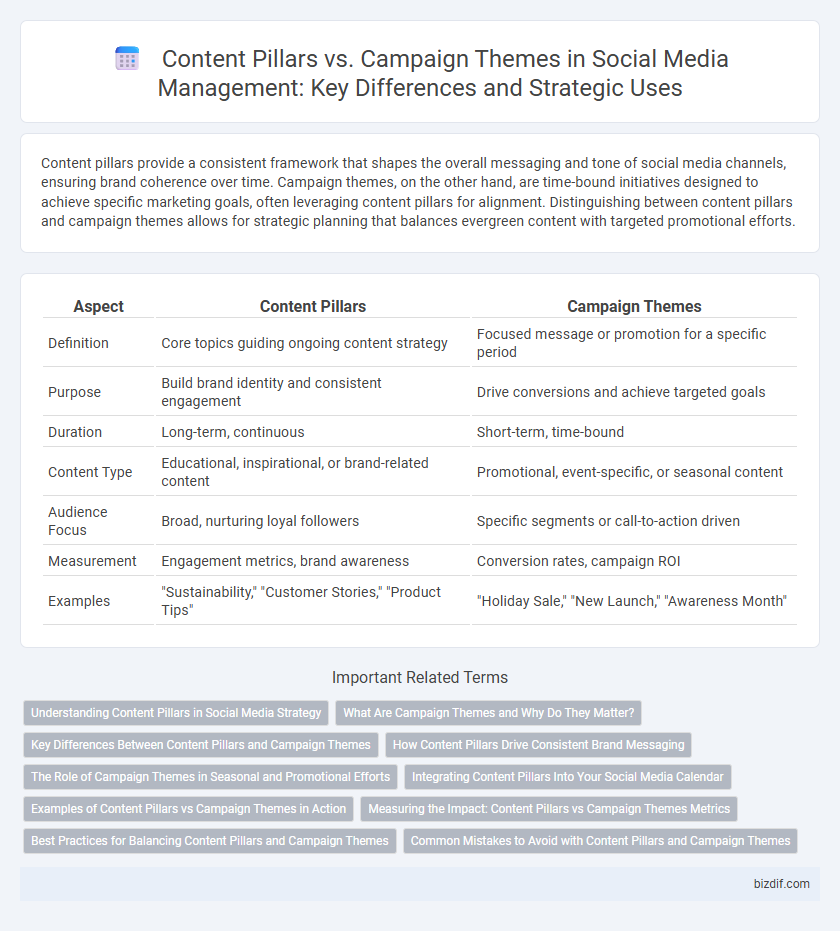Content pillars provide a consistent framework that shapes the overall messaging and tone of social media channels, ensuring brand coherence over time. Campaign themes, on the other hand, are time-bound initiatives designed to achieve specific marketing goals, often leveraging content pillars for alignment. Distinguishing between content pillars and campaign themes allows for strategic planning that balances evergreen content with targeted promotional efforts.
Table of Comparison
| Aspect | Content Pillars | Campaign Themes |
|---|---|---|
| Definition | Core topics guiding ongoing content strategy | Focused message or promotion for a specific period |
| Purpose | Build brand identity and consistent engagement | Drive conversions and achieve targeted goals |
| Duration | Long-term, continuous | Short-term, time-bound |
| Content Type | Educational, inspirational, or brand-related content | Promotional, event-specific, or seasonal content |
| Audience Focus | Broad, nurturing loyal followers | Specific segments or call-to-action driven |
| Measurement | Engagement metrics, brand awareness | Conversion rates, campaign ROI |
| Examples | "Sustainability," "Customer Stories," "Product Tips" | "Holiday Sale," "New Launch," "Awareness Month" |
Understanding Content Pillars in Social Media Strategy
Content pillars in social media strategy serve as foundational themes that guide consistent content creation, ensuring brand messaging remains cohesive and relevant across platforms. These pillars focus on core topics that resonate with the target audience, supporting long-term engagement and authority building. Unlike campaign themes, which are short-term and goal-driven, content pillars provide a steady framework for ongoing brand storytelling and audience connection.
What Are Campaign Themes and Why Do They Matter?
Campaign themes are overarching messages or ideas guiding the strategic direction of marketing efforts across social media platforms. They matter because they ensure consistency, resonate with target audiences, and drive engagement by aligning content with brand values and specific objectives. Effective campaign themes enhance brand recognition, optimize resource allocation, and amplify the impact of promotional activities.
Key Differences Between Content Pillars and Campaign Themes
Content pillars are broad, foundational topics that consistently guide your social media content strategy and establish brand authority over time, while campaign themes are specific, time-bound initiatives designed to achieve particular marketing goals. Content pillars drive long-term engagement by addressing core audience interests, whereas campaign themes create focused messaging bursts to boost visibility and conversions during a designated period. Understanding these key differences helps optimize content planning, ensuring that enduring brand narratives coexist with dynamic promotional efforts.
How Content Pillars Drive Consistent Brand Messaging
Content pillars serve as foundational topics that ensure consistent brand messaging across social media platforms by aligning all posts with core values and audience interests. Defining clear content pillars helps maintain relevance and coherence, preventing fragmented or off-brand communication. Unlike campaign themes, which are temporary and promotional, content pillars provide long-term strategic direction for sustained engagement and brand identity reinforcement.
The Role of Campaign Themes in Seasonal and Promotional Efforts
Campaign themes play a crucial role in seasonal and promotional efforts by providing a cohesive and targeted message that aligns with specific timeframes or events, enhancing audience engagement. Unlike broad content pillars, campaign themes are time-sensitive and designed to drive conversions during key periods such as holidays, product launches, or sales. Leveraging campaign themes helps brands create urgency and relevance, optimizing social media performance through concentrated and well-timed marketing strategies.
Integrating Content Pillars Into Your Social Media Calendar
Content pillars serve as foundational themes that guide your overall social media strategy, ensuring consistent messaging and audience engagement. Campaign themes, on the other hand, are time-specific initiatives designed to promote products, events, or special offers within the broader content pillars. Integrating content pillars into your social media calendar streamlines content planning by aligning daily posts with strategic goals, enhancing brand coherence and maximizing reach across platforms.
Examples of Content Pillars vs Campaign Themes in Action
Content pillars serve as the foundational topics that guide consistent social media content, such as "Health & Wellness," "Product Tips," and "Customer Stories," ensuring brand coherence over time. Campaign themes are time-sensitive promotions or events like "Spring Sale 2024," "Black Friday Discounts," or "New Product Launch," designed to drive engagement and conversions within a specific period. For example, a fitness brand might use "Health & Wellness" as a content pillar to post daily tips, while executing a campaign theme like "Summer Fitness Challenge" to boost participation and sales during that quarter.
Measuring the Impact: Content Pillars vs Campaign Themes Metrics
Measuring the impact of content pillars involves tracking long-term engagement, brand awareness, and audience growth to ensure consistent messaging across channels. Campaign themes metrics focus on short-term performance indicators such as click-through rates, conversion rates, and immediate ROI during specific marketing pushes. Analyzing both sets of metrics provides a comprehensive view of strategic effectiveness and helps optimize future social media management efforts.
Best Practices for Balancing Content Pillars and Campaign Themes
Balancing content pillars and campaign themes requires a strategic approach that aligns core brand messaging with timely, targeted initiatives to maximize audience engagement. Content pillars establish consistent, overarching topics that reinforce brand identity, while campaign themes offer focused, goal-driven narratives tailored to specific marketing objectives. Prioritize maintaining a cohesive voice across all content, schedule regular content audits to ensure thematic relevance, and leverage data analytics to adjust the balance based on audience response and performance metrics.
Common Mistakes to Avoid with Content Pillars and Campaign Themes
Content pillars and campaign themes often get confused, leading to inconsistent messaging and diluted brand identity. A common mistake is treating content pillars as temporary campaign themes rather than foundational topics that support long-term strategy. Avoid overlapping themes that confuse your audience by clearly distinguishing evergreen content pillars from time-sensitive campaign themes for coherent social media management.
Content pillars vs Campaign themes Infographic

 bizdif.com
bizdif.com